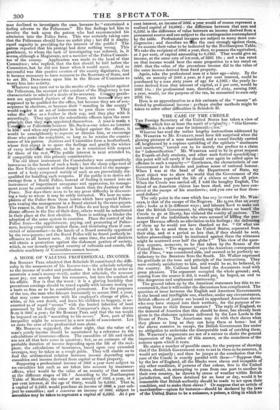Mr. Roznucx suggested, the other night, that the value of
a man's yearly income should be ascertained by a reference to the calculations of insurance-offices. The casualties of life and death are not all that here come in question ; but, as an estimate of the probable duration of income depending upon the life of the reci- pient, the calculations of insurances, based upon very extended averages, may be taken as a rough guide. They will enable us to find the arithmetical relation between income depending upon casualties and income derived from capital or fixed property.
Supposing a professional income of 500/. a year were subject to no casualties but such as are taken into account by insurance- offices, what would be the value of an annuity of that amount at the different stages of life ? According to the Northampton Table of Mortality, the value of an annuity of 5001. a year, at 5 per cent interest, at the age of thirty, would be 6,536/. That is, a capital of 6,5361. would purchase an income of 500/. a year sub- ject to casualties; and e converse an income of 500/. subject to casualties may be taken to represent a capital of 6,5361. At 5 per cent interest, an income of 500/. a year would of course represent a realized capital of 10,000/. : the difference between that sum and 6,536/. is the difference of value between an income derived from a permanent source and one subject to the contingencies contemplated by the table. Professional inc as are subject to many more con- tingencies; and therefore we Nike the case strongly against them, if we assume their value to be indicated by the Northampton Table. - We take the recipient of 500/. a year, then' to possess the equivalent, at 5 per cent, of capital amounting to 6,536/. That would give an income, at the same rate of interest, of 326/. 16s.; and a tax rated on that income would bear the same proportion to a tax rated on 500/. that the value of the precarious income did to the value of the same income derived from fixed property.
Again, take the professional man at a later age—sixty. By the table, an annuity of 500/. a year, at 5 per cent interest, could be purchased by a man sixty years of age for 4,1961.: the yearly in- come derived from that amount of capital, at 5 per cent, would be 2091. 16s.: the professional man, therefore, of sixty, earning 500/. a year, would, for the purpose of the tax, be accounted to earn only 2091. 168.
Here is an approximation to a fair estimate of the " means " af- forded by professional income : perhaps similar methods might be taken to solve other difficulties in Schedule D.


























 Previous page
Previous page